
Plantago is a genus of about 200 species of flowering plants in the family Plantaginaceae, commonly called plantains or fleaworts. The common name plantain is shared with the unrelated cooking plantain. Most are herbaceous plants, though a few are subshrubs growing to 60 cm (24 in) tall.

Psyllium, or ispaghula (isabgol), is the common name used for several members of the plant genus Plantago whose seeds are used commercially for the production of mucilage. Psyllium is mainly used as a dietary fiber to relieve symptoms of both constipation and mild diarrhea, and occasionally as a food thickener. It is commonly used as a food ingredient in manufactured breakfast cereals.

Alisma plantago-aquatica, also known as European water-plantain, common water-plantain or mad-dog weed, is a perennial flowering aquatic plant widespread across most of Europe and Asia from Portugal and Morocco to Japan, Kamchatka and Vietnam. It is also regarded as native in northern and central Africa as far south as Tanzania. It is reportedly naturalized in southern Africa, Australia, New Zealand, Alaska, British Columbia, Washington state and Connecticut. Some sources maintain that the species is widespread across North America, but these reports appear to have been based on misidentified specimens. It is found on mud or in fresh waters.

Alisma is a genus of flowering plants in the family Alismataceae, members of which are commonly known as water-plantains. The genus consists of aquatic plants with leaves either floating or submerged, found in a variety of still water habitats around the world. The flowers are hermaphrodite, and are arranged in panicles, racemes, or umbels. Alisma flowers have six stamens, numerous free carpels in a single whorl, each with 1 ovule, and subventral styles. The fruit is an achene with a short beak.

Plantago lanceolata is a species of flowering plant in the plantain family Plantaginaceae. It is known by the common names ribwort plantain, narrowleaf plantain, English plantain, ribleaf, lamb's tongue, and buckhorn. It is a common weed on cultivated or disturbed land.

Plantago major, the broadleaf plantain, white man's foot, or greater plantain, is a species of flowering plant in the plantain family Plantaginaceae. The plant is native to most of Europe and northern and central Asia, but has widely naturalised elsewhere in the world.
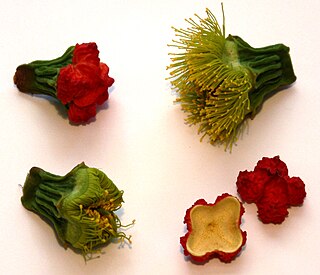
In botany, an operculum is a cap-like structure in some flowering plants, mosses, and fungi.

Plantago ovata, known by many common names including blond plantain, desert Indianwheat, blond psyllium, and isabgol, is a medicinal plant native to Mediterranean region and naturalized in central, eastern, and south Asia and North America.

Plantago maritima, the sea plantain, seaside plantain or goose tongue, is a species of flowering plant in the plantain family Plantaginaceae. It has a subcosmopolitan distribution in temperate and Arctic regions, native to most of Europe, northwest Africa, northern and central Asia, northern North America, and southern South America.
Plantago amplexicaulis is an annual plant of the family Plantaginaceae and the genus Plantago that grows in dry sand and deserts.

Plantago nivalis is a species of flowering plant in the family Plantaginaceae. It is found in the Sierra Nevada of Spain.

Plantago coronopus, the buck's-horn plantain, is a herbaceous annual to perennial flowering plant in the family Plantaginaceae. Other common names include minutina and erba stella.
Plantago debilis is a species of herb native to Australia. Common names include shade plantain and weak plantain.
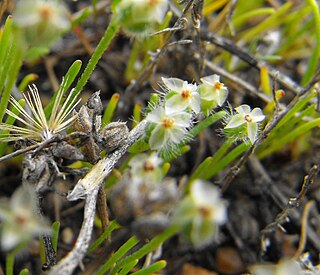
Plantago erecta, in the plantain family, is known variously as California plantain, foothill plantain, dot-seed plantain, English plantain, and dwarf plantain.

The Po Basin mixed forests is an temperate broadleaf and mixed forests ecoregion in the basin of the Po River in northern Italy and Switzerland's Ticino canton.

Jacques-Philippe Cornut or Jacques-Philippe Cornuti or Jacobus Cornutus was a French physician and botanist.
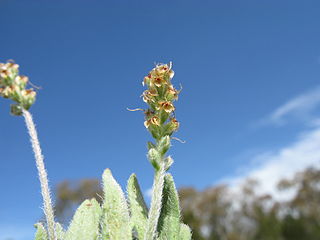
Plantago hispida, the coastal plaintain or hairy plaintain, is a low, dense, tufted herb mostly seen in crevices of rock exposures or other sites with shallow soils. Often found near the sea, but may also be seen in inland sites with low rainfall. This is one of the many plants first published by Robert Brown with the type known as "(D.M.) v.v." appearing in his Prodromus Florae Novae Hollandiae et Insulae Van Diemen in 1810. The specific epithet hispida is derived from Latin, meaning "rough", however this is misleading as it doesn't appear relevant to this plant.

Plantago aucklandica is a flowering plant in the family Plantaginaceae that is endemic to the Auckland Islands.
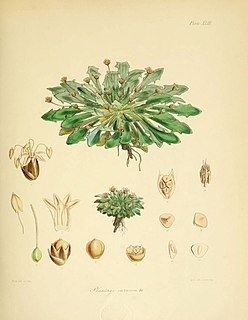
Plantago triantha is an annual plant of the family Plantaginaceae that is found in both Tasmania and the Auckland Islands.
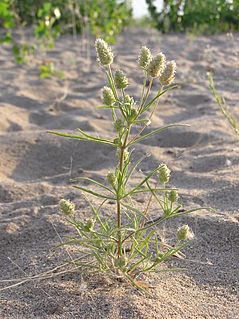
Plantago indica, commonly known as branched plantain, sand plantain, or black psyllium, is a flowering plant in the plantain family Plantaginaceae, and is one of a few species in the Plantago genus under the common name psyllium. The plant is native to parts of Africa, Europe, Russia, and Asia, and has been naturalized in many other areas such as Australia and North America. The plant can be found mostly in dry inland areas, such as those that are sandy, and has also naturalized on roadsides and in meadows. The plant is not used broadly as a food source, but has been cultivated for its seeds which serve a medicinal use as a laxative.

















